From the series of articles "Lightning protection of oil and gas facilities".
1.1. Requirements of national regulations
The national standard "Instructions for lightning protection of buildings, structures and industrial communications", the document known as IS-153-34.21.122-2003, doesn't contain any special requirements, due to what experts have to turn to the "Instructions for lightning protection of buildings and structures AD 34.21.122-87 ", which was developed in the interests of the State Committee for Construction of the USSR applcable to a completely different economic policy and, most importantly - an element base of control circuits, automation and transmission of operational information.
According to the instructions of AD 34.21.122-87 objects with explosive facilities of classes E-I belong to the I category of lightning protection, which should necessarily be carried out with separate lightning rods. The latter should be mounted at certain distances to the protected object by air (SA) and by ground (SG), which are regulated depending on the height of the object and the resistivity of the ground in the place of their installation. It is characteristic, that the standard requirements were limited to the electric resistance of 1,000 Ohm * m (SB = 12 m for objects up to 30 m in height). For soils of lower conductivity the question remains open. The insulation distance in the soil, where it should be selected as the S3 = SB+ 2 m is standardized in the same range of electrical resistivities.
Lightning rods of objects of the I category of lightning protection should provide protection zones of type A.
According to AD 34.21.122-87, all outdoor facilities, creating hazardous areas of class B-Ir, must be equipped with means of lightning protection of the II category. Lightning rods, natural or specially designed, can be installed directly on the facility and in its surroundings. It is allowed to use lightning protection meshes. Further the instructions give the differentiation of requirements to lightning rods, depending on the volume of the stored hydrocarbon fuel. For example, tank farms with a total volume of combustible gases and flammable liquids over 100 000 m3 as a rule, should be protected with separate lightning rods. For liquefied gases in this respect the ultimate figure is reduced to 8000 m3. As for the metal wall thickness of large-sized tanks, then it does not matter in this situation. On the contrary, for individual tanks (now, regardless of volume!) protection with lightning rods is obligatory at the thickness of the metal roof less than 4 mm, and if the walls are thicker, it is not necessary to install lightning rods at all. Finally, if the volume of metal tanks are less than 200 m3 lightning rods are not required regardless of the shell thickness.
I should confess I could not find logic in that. The neglection of a fire after the lightning channel burns the thin metal roof, when the flame covers the amount of gasoline of 3 - 4 tankers, confuses me a lot. I also wondered about mandatory lightning protection of large thick-walled steel tanks, not punched by lightning at all, but here, it was prescribed to use freestanding lightning rods only. I should say, that the reference to the danger of ignition of flammable gas mixtures over tanks's vent valves dosn't clarify the problem. It will be shown below that to ignite such a mixture with lightning electricity, no contact with the lightning channel is required.
Now about the required reliability of protection with lightning rods. It is not indicated in AD 34.21.122-87. You can find information only in its Manual. Section 7 of this document states that the A protection zone can be attributed of the reliability of 0.995, and zone B - 0.95. Both these values remain on the conscience of the authors. A special check with the help of the program, prepared on the basis of statistical methods, showed that the true reliability of zone A doesn't exceed 0.96, and zone B - 0.84. This is significantly less than what is required today for I and II lightning levels (0.98 and 0.95 respectively).
1.2. Requirements of enterprises' standards
It is impossible to consider requirements of all standards without exception. Therefore, we've chosen only two very different approaches to the problem. JSC "Transneft" standard prescribes to provide the I lightning protection level for all tanks with liquid fuel, irrespective of their volume. For other outdoor facilities with liquid fuel, the II lightning protection level is considered sufficient. Reliability of the I protection level is taken equal to 0.99; for II level it is reduced to 0.95. It is crucial that Standard allows the use of lightning protection meshes, though only of European sizes - 5x5 m for lightning protection level I and 10x10 m for level II. It is a pity, that the authors did not explain what is the fundamental difference between the meshes of selected sizes from national meshes 6x6 m and 12x12 m. It is hard to imagine that the reduction of the cell sizes of the mesh on 1 m is so important that it becomes suitable for the I level protection from direct lightning strikes. It seems that the authors of the Standard don't have any doubt about that. In any case, they require positioning of the mesh 10 cm above the combustible roof covering, assuring that with such an excess the mesh will intercept almost all lightning discharges, preventing their contact with combustible materials. The latter can be checked using the above-mentioned computer program that was used to calculate the lightning protection zones in IS-153-34.21.122-2003. The calculation was performed for the mesh with cells 5x5 m, which would have to provide the object with dimensions of 20x20 m. with the reliability protection of not less than 0.99 in case of its excess over the roof to 0.1 m. In reality, the values obtained for the probability of a lightning break passing the mesh are shown in Fig. 1 depending on the height of the object. It is easy to make sure that they are in the range of 0.37 - 0.48 and, therefore, the reliability protection barely exceeds 0.5, but not 0.99 as it is considered by the standard compilers.
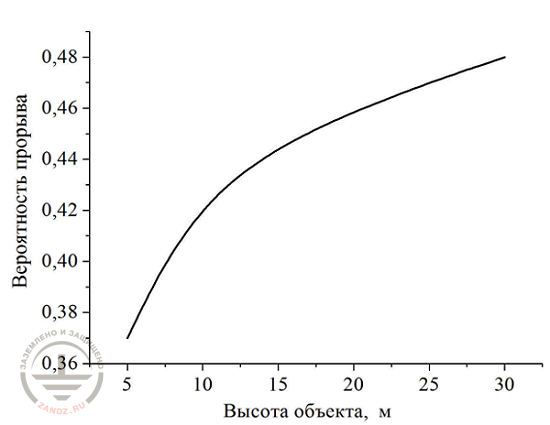
Figure 1. Calculated values of the probability of a lightning break passing the lightning protection mesh, raised above the roof to 0.1 m (assuming the presence of grounded metal structures under the roof)
Вероятность прорыва – probability of breakthrough
Высота объекта, м – object height, m
In case when a lightning rod has a common ground electrode system with the protected facility, the distance between them over the air should be less than 3 m at the soil resistivity ρ ≤ 100 ohm m, and when ρ> 100 ohm m it should be increased to 4 Ohm * m. The authors don't explain what is the magic power of number 100, but that would be desirable, especially because the EMF of magnetic induction acting in this air gap doesn't depend on soil resistivity, but it noticeably reacts to the height of the object (but there is no word about it). The requirement of the insulation distance of 5 m in all soils, when the lightning rod has its own grounding device, is also not explained. Two questions appear here. Firstly, such a distance can be easily blocked by a spark channel, sliding along the ground surface (for more details see section 3). The higher is the specific resistance of the soil, the more probable is its formation. Secondly, at the distance of about 5 m even in the absence of spark channels, almost 50% of the lightning current may fall into the object's ground electrode system due to the natural soil conductivity. As you can see, these are quite fundamental questions.
As for the regulatory requirements of the Standard of JSC "Gazprom", then there is almost no formal logical contradictions in it. For outdoor installations, lightning protection of level II is required, and, lightning rods both detached and mounted on the roof of protected objects, must ensure the reliability of not less than 0.99. Lightning protection mesh as the primary means of protection against direct lightning strikes is not considered. The choice of simple lightning rods can be carried out according to their protection zones, similar to those from the IS-153-34.21.122-2003, systems of several lightning rods of any design are prescribed to be designed using a standard computer program (development of "ENIN" JSC). The distance between the separate lightning rods and the object should be not less than 7 m (ρ ≤ 500 Ohm m) and increases with the incease of p up to 15 m according to the empirical formula
1.3. Design in accordance with the regulations
After the analys it is difficult to get rid of the thought of complete refusal from lightning rods. Indeed, when the thickness of the steel wall is more than 4 mm, a direct lightning strike cannot burn or overheat it. This statement is accepted by all specialists in all technically developed countries. A direct lightning strike into the tank with hydrocarbon fuel itself won't bring to a fire. Lightning current is also not dangerous for the tank foundation. If this foundation is made of reinforced concrete, it can be used to divert the lightning current into the ground, as it is done for other industrial facilities. Now about the zone of emissions of combustible gases from the vent valves in normal process conditions. When the gas mixture contacts with a lightning channel , its flash is very, very likely. It is for this reason the regulations AD 34.21.122-87 require mandatory inclusion of all the explosive volume over the vent valve into the protection zone of the lightning rod. The measure is quite reasonable, but in practice little effective for a number of reasons.
A lightning channel rarely appears alone. According to the generalized notions of CIGRE (2013). Up to 50% of lightning contact with the ground and objects on it by several channels. The number of pending branches is even more (Fig. 2). The current in them is insignificant, but the temperature certainly exceeds 5000 K. The lightning rod will intercept only one, main, branch. The rest can freely achieve the hazardous area and set it on fire. However, it is not the only cause of weakening of the lightning rod effectiveness. In Section 4, you will see that not only the lightning discharge can carry out ignition, but also other low-voltage gas-discharge elements, initiated in stormy conditions. Lightning rods are not intended to deal with them at all.
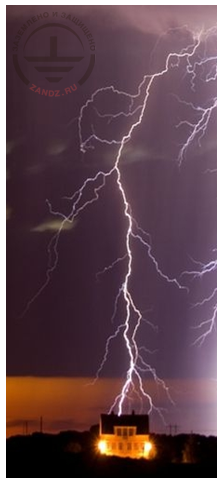
Figure 2. Example of lightning with several branches
The statement about the safety of a lightning rod doesn't bring calm. In fact, it can cause additional hazards on modern electronics of the facility, because installation of a lightning rod increases the height of the building. Separate lightning rods do it extra notably. Together with the height, the number of close lightning strikes increases. For example, for a lightning rod it is proportional to the square of the height. Each strike is accompanied by exposure of electromagnetic field of lightning to the object. Its consequences can be quite severe. Damage of sensors of automatic fire-extinguishing system is one of them. It is clear that there should be special necessity to do that.
There is only one argument against that, but it's very powerful - the bodies of state technical inspection will necessarily require installation of lightning rods, since they have been prescribed by the regulations. Designers don't have any weapon against it. They have to carry out the prescribed regulatory requirements, but it is possible to manage with small losses. Lightning rods should be minimally high and very cheap, if possible. If it is possible to remove them from fuel tanks, it will be especially welcomed. Probably any experienced professional can find appropriate solutions. Personally I particularly like catenary wire lightning rods.
Catenary wire lightning protection is not too popular among designers of industrial buildings, although electric industry engineers use it very extensively for the protection of overhead transmission lines of 110 kV and higher. One or two grounded wires are hung above the phase conductors of such lines (sometimes they are isolated from the supports to small voltages and are used as communication channels). The wires act as lightning rods along the entire length of the line. Wires with negative protection angles are characterized by particularly high reliability, when they are placed with a shift outwardly with respect to the phase conductors and therefore the lightning meets them first (Fig. 3).
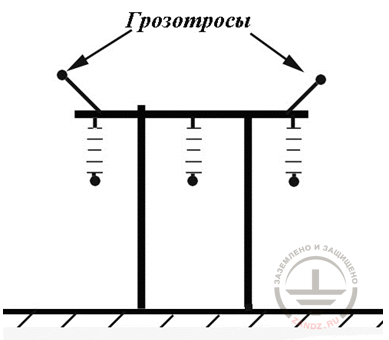
Figure 3. Example of a lightning protection with cables of negative angles
Грозотросы – ground wires
Fixation of ground wires with negative angles of protection is not too popular for the transmission lines hundreds of kilometers in length due to a significant rise in price of supports with remote ground wire supports. In addition, the discussions on the reliability of the protection of the line central phase conductor, which some experts consider to be too open, are still going on. With respect to tank farms, the problem doesn't appear, firstly because their length does not exceed a few hundred of meters, and therefore the additional cost on the supports are negligible, and secondly, protection of the central part of territory can be easily enhanced by the placement of another wire (Fig. 4).
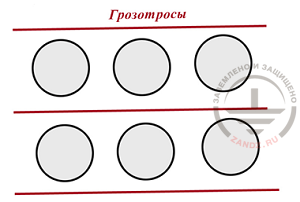
Figure 4. Wire protection of a tank farm
Грозотросы – ground wires
Computer calculation results in Fig. 5 show the dependence of the probability of a lightning breakthrough into the territory of the tank farm of 100 m in length on the distance between the ground wires 25 min height, protecting objects 20 meters high. It is assumed that removal of the cables to the exterior area with respect to the protected object is only equal to 5 m.t
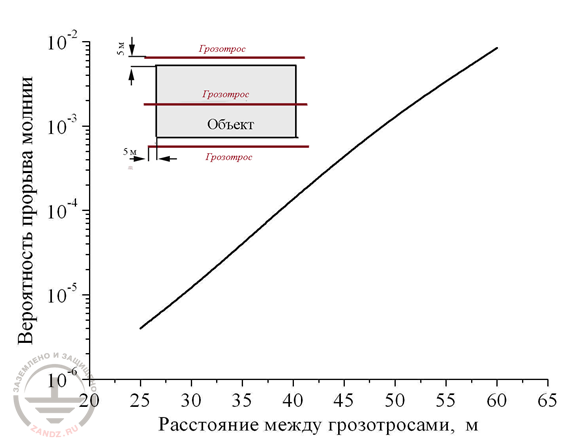
Figure 5. To the estimation of the reliability of tank farm protection by multi-wire system
Вероятность прорыва молнии – probability of lightning breakthrough
Грозотрос – ground wire
Объект - object
Расстояние между грозотросами, м – distance between the ground wires, m
Special attention should be paid to the high efficiency of multi-wire lightning protection at exclusively small elevation of cables over the protected object (Fig. 6), in the result of what their use practically does not increase the frequency of lightning strikes into the system and therefore leaves the number of dangerous electromagnetic effects of lightning current almost unchanged. The length of the protected area, and consequently the ground wires, has no significant influence on the likelihood of a breakthrough.
E. M. Bazelyan, DEA, professor
Energy Institute named after G.M. Krzyzanowski, Moscow
Read more "2. Ground of lightning rods".
Useful materials:
- Series of articles about lightning protection for beginners
- Series of webinars about grounding and lightning protection with Professor E. M. Bazelyan
- Elements of external lightning protection
- Consultations on the selection, design and installation of grounding and lightning protection systems
Related Articles:



